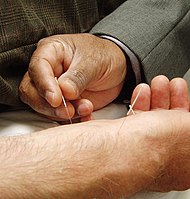
Photo from wikipedia
Severe acute respiratory syndrome coronavirus 2 (SARS‐CoV‐2) is a global pandemic that has spread all over the word. To avoid the virus transmission, healthcare workers must wear adequate personal protective… Click to show full abstract
Severe acute respiratory syndrome coronavirus 2 (SARS‐CoV‐2) is a global pandemic that has spread all over the word. To avoid the virus transmission, healthcare workers must wear adequate personal protective equipment (PPE). PPE is associated with several side events, including skin reactions. The objective of this study was to summarize the prevalence, type and risk factors for cutaneous adverse events related to PPE and prevention measures to avoid them. A systematic review and meta‐analysis was conducted using MEDLINE, Scopus and EMBASE databases from conception to 21 January 2021. All types of epidemiological studies regarding skin adverse events related to PPE were included. The literature search identified 1007 references, 35 of them met the eligible criteria and were included for analysis, representing 31 453 participants. The media of skin side events related to PPE was 75.13%. The rate of cutaneous adverse events related to mask was 57.71%, and those associated with gloves and hand hygiene products was 49.16%. Most common skin adverse events were contact dermatitis, acne and itching. The most damaged anatomical regions were the nasal bridge, the cheeks and the hands. The duration of PPE wearing was the most common risk factor. Frequent handwashing, gloves and masks were the agents most frequently related to skin reactions. N95 respirators were the most harmful mask type for the skin. Hydrocolloid use prevented from developing skin adverse events related to masks. In conclusion, the rate of cutaneous adverse events related to PPE use is high. A longer duration of PPE wearing was the most common risk factor. Using hydrocolloid could prevent from skin injuries related to mask use.
Journal Title: Journal of the European Academy of Dermatology and Venereology
Year Published: 2021
Link to full text (if available)
Share on Social Media: Sign Up to like & get
recommendations!